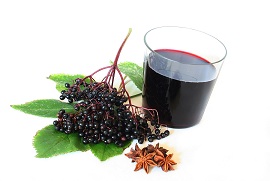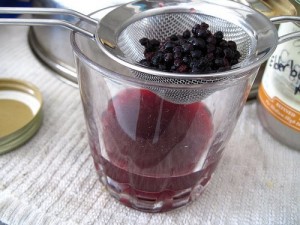The Mysterious Elderberry Juice
Elderberries are tiny, dark berries that grow in clusters on elder shrubs or elder bushes. In plant taxonomy, they belong to the genus Sambucus and family Adoxaceae. Elderberries exist in several varieties and can grow in temperate to subtropical regions of both Northern Hemisphere and the Southern Hemisphere.  Elderberry shrubs often grow in moist soils along roadsides and streams. Indigenous elderberries were cultivated by people for the purpose of supporting native butterfly and bird species. They have been used as a folk remedy for centuries in several Western countries and were thought to assist in curing a variety of illnesses. Due to these claims, several studies were conducted on elderberry’s nutritional profile and health benefits. The medicinal benefits of elderberries are continuously being investigated and rediscovered but one thing is for sure, their antioxidant capacity is outstanding.
Elderberry shrubs often grow in moist soils along roadsides and streams. Indigenous elderberries were cultivated by people for the purpose of supporting native butterfly and bird species. They have been used as a folk remedy for centuries in several Western countries and were thought to assist in curing a variety of illnesses. Due to these claims, several studies were conducted on elderberry’s nutritional profile and health benefits. The medicinal benefits of elderberries are continuously being investigated and rediscovered but one thing is for sure, their antioxidant capacity is outstanding.
The Varieties of Elderberry!
These are the popular and common varieties of elderberries.
First is the European Elder, also called Black Elder or Common Elder. Scientifically it is called Sambucus nigra and is found around warmer parts of Europe and North America.
The berries of the European elder are dark blue to black and this type is most frequently used in cooking recipes.
The American elder or the sweet elder bears sweeter berries compared to the previous variety.  Because they are slightly sweet, they are often used as an ingredient to many cuisines. The Sweet Elder is scientifically known as Sambucus Canadensis and can be found in North America.
Because they are slightly sweet, they are often used as an ingredient to many cuisines. The Sweet Elder is scientifically known as Sambucus Canadensis and can be found in North America.
The red-berried elder or Sambucus racemosa obviously bears bright red berries. This variety grows around the coolest parts of North America and is believed to be poisonous when eaten. 
Some people claimed that red elderberry is poisonous unless carefully seeded and cooked. Some say it remains poisonous regardless of what’s done with it. So if you’re planning to cook or juice elderberries, pick the blue, black or dark purple varieties and leave the red berries alone.
Eat and Juice Elderberries Safely!
There are several hear-says about elderberry varieties containing a specific toxin that may be harmful to humans. The truth is certain parts of the elderberry shrub are really poisonous and these parts shouldn’t be ingested or used in cooking recipes. The poisonous parts in elderberry include the leaves, twigs, branches, seeds and roots. They contain a cyanide-inducing substance that produces a toxic level of cyanide in the body once ingested. Since we don’t have the luxury of time and resources to know whether these claims are true or not, it’s wiser and safer to be cautious in using elderberries in cooking. Make sure they are washed, cleaned and seeded before adding them into dishes and before juicing. However, some say we don’t have to worry about these berries because birds and humans have eaten them for centuries, saying they aren’t poisonous, except for the red ones.
The Health Benefits of Elderberry Juice
Supports Respiratory System and Treats Flu
The ability of elderberry in reducing mucus production and alleviating inflammation of the sinus and mucous membranes makes elderberry juice very ideal in terms of preventing and treating respiratory illnesses. Asthma, bronchitis, common cold, sore throat, cough and flu or influenza are just some of the respiratory ailments that elderberry could ease. These illnesses produce signs and symptoms which are mostly curable by elderberry. Elderberry also helps in the drainage of mucus from the sinuses thereby reducing nasal congestion. In fact, elderberry juice, especially those made with black elderberries were used in treating a flu epidemic in the year 1995.
Anti-cancer and Anti-AIDS Properties
Elderberry contains bioflavonoids and vitamin C which are both known to be potent antioxidants that could help prevent cell damage, boost immune system and stop the occurrence of bacterial and viral infections. It has been identified through extensive studies that elderberry stimulates the immune system to function optimally. Because of this, elderberry has been used to treat patients with cancer and AIDS.
Reduces Bad Cholesterol
Elderberry juice also helps in regulating and reducing bad cholesterol levels in the body by inhibiting oxidation of low-density lipoprotein, thus reducing our risks to atherosclerosis and heart attacks. Drinking elderberry juice has been a preventive and curative measure for people with Diabetes.
Outstanding Antioxidant Activity
Elderberries contain bioflavonoids and anthocyanins which possess significantly more antioxidant capacity than vitamin E or vitamin C. Anthocyanins enhance immune system by increasing the production of cytokines, protein messengers that regulate immune response in the body.
Elderberry Juice Recipe!
This recipe teaches you how to make a refreshing, healthy drink, elderberry juice. You can also turn this into a concentrated syrup which you may use in a variety of dishes. Before following this recipe, you need to pick fresh elderberries on a dry, warm day.
Ingredients:
- 1kg elderberries
- 375 ml water
- 450 g sugar
- Ginger
- One Lemon for every pint of elderberry juice
Equipments:
- Stainless steel pan
- Sieve or cheesecloth
- funnel
Instructions:
- Wash and clean the berries well. Drain thoroughly and remove their heads using a fork.

- Place elderberries in a stainless pan and cover with water. Bring to a boil and simmer until tender. This usually takes 25-30 minutes.
- Remove from pan and strain well using a sieve or cheesecloth. Squeeze out all the juice with your clean hands.
- Add sugar and one lemon per for every pint of the extracted juice.
- Store in refrigerator to chill, and then serve cold
If you want to make a concentrated elderberry syrup, add 1lb of sugar for every pint of elderberry juice, return the juice to heat and boil for another 10 minutes until sugar is dissolved. Let it cool and place in sterilized bottles.
More Articles On Elderberries And Elderberry Juice
Best Elderberries For Elderberry Juice And How To Choose Them
Elderberries juice contains many important nutrients and is quite delicious …Elderberry Juice Side Effects – Can You Drink Too Much Of It?
Checking for the safety recommendations and possible side effects of …Elderberry Nutrition Facts
Elderberry Nutrition Facts Betaine 0 mg Calcium 38 mg Calories …The Natural Health and Beauty Benefits of Elderberry Juice
Elderberries are heaving with a range of nutrients that everyone …